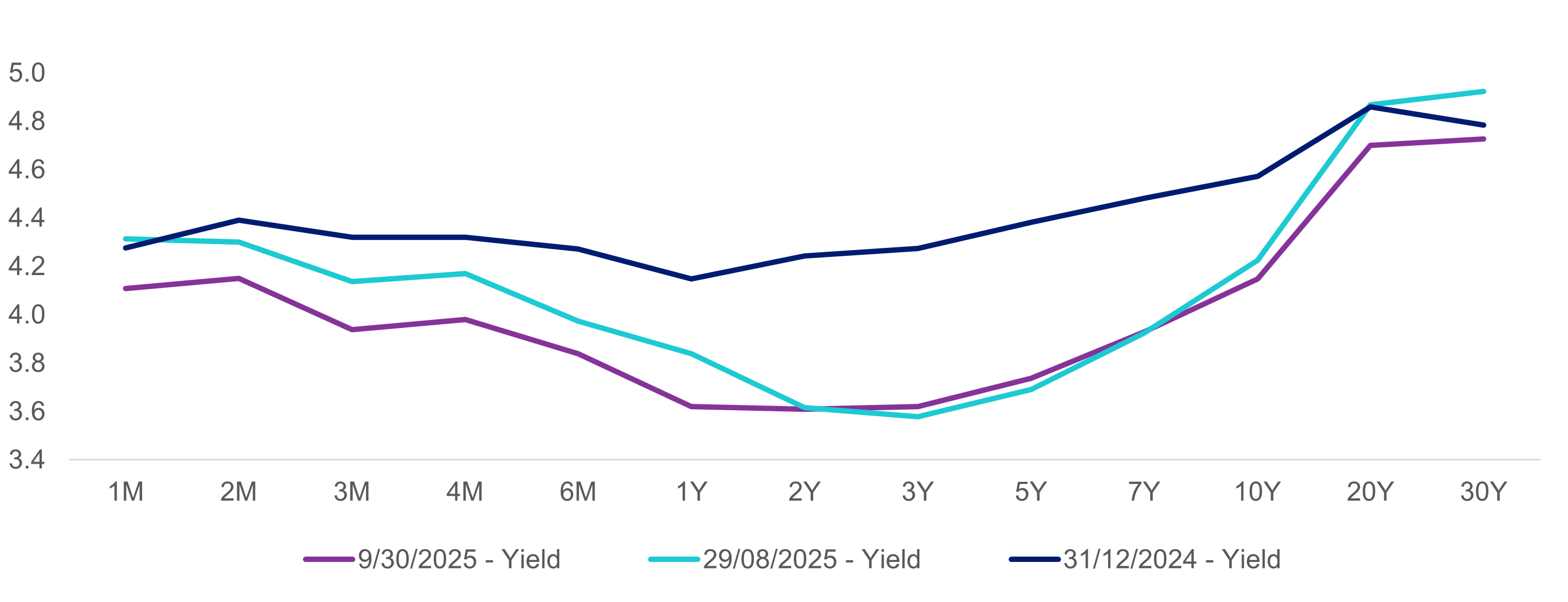Despite the government shutdown and the Congressional standoff regarding the upcoming fiscal year federal government funding, it was another solid month for risk assets. Global capital markets continued an upward trajectory driven by strong corporate earnings, along with what is anticipated to be the first of several Fed rate cuts given concerns about a weakening labor market and uncertain inflationary pressures.

| Equity | YTD (%) | MTD (%) |
|---|---|---|
| All Cap U.S. Stocks |
|
|
| Russell 3000 | 14.4 | 3.5 |
| Growth | 16.8 | 5.1 |
| Value | 11.5 | 1.5 |
| Large Cap U.S. Stocks |
|
|
| S&P 500® | 14.8 | 3.6 |
|
Russell 1000 |
14.6 | 3.5 |
| Growth | 17.2 | 5.3 |
| Value | 11.7 | 1.5 |
|
Mid Cap U.S. Stocks |
|
|
|
S&P 400 |
5.8 | 0.5 |
|
Russell Midcap |
10.4 | 0.9 |
| Growth | 12.8 | -0.3 |
| Value | 9.5 | 1.3 |
| Small Cap U.S. Stocks |
|
|
| S&P 600 | 4.2 | 1.0 |
| Russell 2000 | 10.4 | 3.1 |
| Growth | 11.7 | 4.2 |
| Value | 9.0 | 2.0 |
| International |
|
|
| MSCI EAFE NR (USD) | 25.1 | 1.9 |
| MSCI EAFE NR (LOC) | 13.6 | 1.8 |
| MSCI EM NR (USD) | 27.5 | 7.2 |
| MSCI EM NR (LOC) | 24.3 | 7.1 |
| Fixed Income | YTD (%) | MTD (%) |
|---|---|---|
| Bloomberg |
|
|
| U.S. Aggregate | 6.1 | 1.1 |
| U.S. Treasury: 1-3 Year | 4.0 | 0.3 |
| U.S. Treasury | 5.4 | 0.8 |
| U.S. Treasury Long | 5.6 | 3.1 |
| U.S. TIPS | 6.9 | 0.4 |
| U.S. Credit: 1-3 Year | 4.6 | 0.4 |
| U.S. Intermediate Credit | 6.5 | 0.7 |
| U.S. Credit | 6.9 | 1.4 |
| U.S. Intermediate G/C | 5.7 | 0.4 |
| U.S. Govt/Credit | 5.9 | 1.1 |
| U.S. Govt/Credit Long | 6.6 | 3.1 |
| U.S. MBS | 6.8 | 1.2 |
| U.S. Corp High Yield | 7.2 | 0.8 |
| Global Aggregate (USD) | 7.9 | 0.7 |
| Emerging Markets (USD) | 8.5 | 1.1 |
| Morningstar/LSTA |
|
|
| Leveraged Loan | 4.6 | 0.4 |
| Alternatives | YTD (%) | MTD (%) |
|---|---|---|
| Bloomberg Commodity | 9.4 | 2.2 |
| S&P GSCI | 6.1 | 0.6 |
Source: Segal Marco Advisors
The S&P indices are a product of S&P Dow Jones Indices, LLC and/or its affiliates (collectively, “S&P Dow Jones”) and has been licensed for use by Segal Marco Advisors. ©2025 S&P Dow Jones Indices, LLC a division of S&P Global Inc. and/or its affiliates. All rights reserved. Please see www.spdji.com for additional information about trademarks and limitations of liability.
Macroeconomics
The Fed reduced its benchmark rate by 25 basis points to 4.00–4.25 percent in September, with further rate cuts anticipated despite moderately elevated inflation data, given continued weakness in labor markets. August’s monthly CPI increase of 0.4 percent lifted annual inflation to 2.9 percent as the impact of current and anticipated price increases from tariffs continued to slowly seep into the economy. The Fed’s preferred measure of inflation, Core PCE (Personal Consumption Expenditures), increased by 0.2 percent in August with an annualized rate of 2.9 percent.
The ISM Manufacturing PMI survey results increased slightly to 49.1 in August, but the overall negative trend continues in lower employment, inventories and new orders. The annualized unemployment rate increased to 4.3 percent in August, with further weakness in labor markets as the Bureau of Labor Statistics reported below consensus hiring estimates of 22,000 jobs vs. the 75,000 forecast, along with a combined net downward revisions to June and July of 21,000 jobs. The Conference Board Consumer Confidence Index survey fell 3.6 points in September to 94.0.
Equity markets
U.S. equities had a fifth consecutive month of positive returns, with the S&P 500 up 3.6 percent as it hit 23 record closing highs to make this the best September performance in fifteen years. On a sector basis, Information Technology (+7.3 percent) was the top contributor, with Materials (-2.1 percent) the weakest. Russell 1000 large U.S. cap stocks (+3.5 percent) outpaced Russell 2000 small-cap stocks (+3.1 percent) and Russell midcap stocks (+0.9 percent). Russell 3000 all-cap growth index (+5.1 percent) outperformed Russell 3000 all-cap value index (+1.5 percent) during the month.
International equity markets were also positive, with emerging regions (EM +7.2 percent) significantly ahead of developed regions (EAFE +1.9 percent). Within developed markets, Europe (+2.0 percent) outperformed Pacific (+1.7 percent) on a regional basis. Within emerging markets, Asia (+7.5 percent) ouperformed Latin America (+6.5 percent ) and Eastern Europe (+1.6 percent) on a regional basis.
International markets have outperformed the U.S. S&P 500 (14.8 percent) year to date; helped by the weakened U.S. dollar, as the MSCI EAFE (25.1 percent) was significantly ahead of the MSCI EAFE Local Currency (+13.6 percent) and the MSCI EM (27.6 percent) was ahead of the MSCI EM Local Currency (+24.3 percent).
Fixed income markets
Fixed income markets were positive, with the Bloomberg U.S. Aggregate Index up 1.1 percent. The U.S. Treasury yield curve modestly steepened in anticipation of further rate cuts and weakening employment data, as 1-year U.S. Treasuries declined (22 bps to 3.6 percent) slightly more than 30-year Treasuries (14 bps to 4.7 percent). Mortgage-backed securities, investment-grade corporates and high yield all had spreads tighten with heavy new issuance of the latter to take advantage of a favorable rate environment.
U.S. Treasury Yield Curve

Source: Factset
Looking ahead
September ended on the eve of a government shutdown of unknown duration due to political differences regarding fiscal spending. Generally, the stock market has taken such events in stride, but that may ultimately depend on the length of the stalemate. The shutdown does mean that certain key economic monitoring data, including the September U.S. jobs report, will not be available from government sources. The Fed, having prioritized weakening labor market conditions with the September rate cut decision, may look to private sector jobs data at their October policy meeting. As such, it is worth noting that payroll processor ADP reported a net loss of 32,000 corporate jobs in September, which is suggestive of a slowing economy and further monetary policy easing.
See more insights

U.S. Economy Posts Strong Second Quarter Results

Looking Down the Barrel of a Government Shutdown

August 2025 Financial Markets
The information and opinions herein provided by third parties have been obtained from sources believed to be reliable, but accuracy and completeness cannot be guaranteed. This article and the data and analysis herein is intended for general education only and not as investment advice. It is not intended for use as a basis for investment decisions, nor should it be construed as advice designed to meet the needs of any particular investor. On all matters involving legal interpretations and regulatory issues, investors should consult legal counsel.
